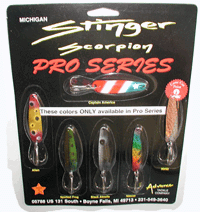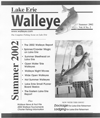The strongest, and most fragile link you have between
yourself and a fish is undoubtedly your fishing line. Choosing an inferior
product in order to save a few bucks, or picking the wrong style for the
type of fishing you do, can lead to heartbreak when out on the water. So
what are the best lines to choose and when should you use them? The
following will hopefully explain the subtleties of the common "fishing
line."
Monofilament
Monofilament is the most commonly used line when it comes
to fishing, and is a mainstay on the majority of angler's reels. The one
problem many anglers make the mistake of is buying the cheapest mono they
can find. In fishing, you normally get what you paid for, so spend a little
bit extra and buy a reputable brand. Berkley Trilene, SilverThread, Stren
and Ande all have proven track records, and make a high-quality line. It is
also important to change your line regularly - at the bare minimum once a
season - as the sun and water will break down the line, leaving it weak and
partial to breakage.
Mono is a great line to choose when you are faced with
clear water conditions. This type of line is virtually invisible once it is
under the water's surface, and can really up your odds for "line-shy" fish
and those with excellent eyesight. Mono can be used for virtually every
fishing situation you may encounter, and it is generally regarded as the
best all around fishing line for all situations. (Braided lines fill some of
these cracks when it comes to specific techniques.)
Monofilament will stretch a fair bit on hook sets, so
extra force is generally required to drive the hook home. (Compared to the
no-stretch traits that braided lines have, where less force is definitely
needed.) Mono is generally a strong line, most are extremely abrasion
resistant and are thin in diametre. One problem that many find with mono is
the "reel memory" that this type of line has. Coils and loops are common
occurrences for the mono angler, which can lead to backlashes and knotted
lines on reel spools. One remedy for this unpleasant aspect is to make sure
you are using the correct line weight for the reel size you are using.
Unless you are doing Great Lakes salmon fishing with a spinning reel, the
maximum line strength I suggest for freshwater applications is ten-pound
test. Anything higher and coils, backlashes and tangles will rear their ugly
heads. Your distance and accuracy will also suffer by going above this
recommendation. Anything higher than ten-pound test is best fished on a
baitcasting reels. There are certain situations and styles of fishing that
afford some leeway in this generalization, but for most anglers chasing
bass, walleye or panfish, this advice will make your fishing much more
enjoyable.
The Braided Lines
Braided lines have come on strongly over the past few
years, and more and more anglers are realizing the advantages these lines
possess for specific situations and techniques. Braided lines are made by
"braiding" or "weaving" fibers of a man-made material like Spectra or Micro-
Dyneema into a strand of line. This process produces a line that is very
strong, extremely abrasion resistant and has virtually no stretch
whatsoever.
They are also extremely thin in diametre in comparison to
the equivalent monofilament pound-test rating. What this means is that you
are to choose a braid in a similar line diameter to the mono you would
normally use - not the pound-test that you would use. If you generally use
ten-pound test mono, the equivalent braided line might have a thirty to
fifty-pound rating.
Two of the most popular braids on the market would have
to be Power Pro and Spider Line. Both make highquality products. One other
thing to consider is the price of braided lines. It can be two to three
times as pricey as regular mono, but it doesn't have to be changed as often.
The majority of anglers leave a backing of mono on their reels and tie on 50
or 75 yards of braid to fill the spool up. This will also save you money in
the long run.
Braids also have some interesting characteristics that
can be both good and bad. Due to the "no-stretch" capabilities of the line,
a simple flick of the wrist is often all it takes to set the hook into the
mouth of a fish. Rear back like you do with mono and you very well could
break your rod, line or hook. Although the newer braids have come along way
since their inception, they can still wear down equipment such as line
guides and reel arms due to their strong makeup. Make sure that your
equipment is capable of handling this tougher line before you spool up. Reel
memory is also in sharp contrast to mono - there is none. This can mean
smoother casts and less chance of backlashes and tangles.
Specialized techniques is where braided lines really
shine, and things such as jigging, crankbaits and topwaters are all areas
that braids can improve your fishing. When jigging with braids, you are able
to feel every piece of structure, weed or light bites. And you have a direct
and immediate hookset without the stretch. Crankbaits will dive deeper and
feelings will be heightened through the use of braids. And since the line
floats, topwater fishing can done more easily and efficient. (One key is to
not pull the lure away due to the no-stretch braid..)
Fishing line has come a long way since it's inception,
and new strides are being made each year. Consider these tips the next time
you're in the "line aisle," and watch your angling skills grow in leaps and
bounds.




